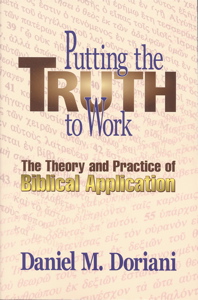Doriani, Daniel M. Putting the Truth to Work: the Theory and Practice of Biblical Application. Phillipsburg, New Jersey: P&R Publishing, 2001. 342pp. $17.99 (much $11.69 at wtsbooks .
INTRODUCTION
As a companion to his excellent work, Getting the Message, Daniel Doriani published Putting the Truth to Work in 2001. In Getting the Message (Hereafter, GTM), Doriani gave a basic outline for the beginning stages of hermeneutics and exegesis. In Putting the Truth to Work, the author seeks to apply the basic principles set forth in GTM, through the CAPTOR method of exegesis to the greater task of application.
Though wide in scope, the book seeks to answer the main question, “Is the Bible relevant?” (1). That is, in short, what application is all about. Showing readers and hearers how the Bible, as a whole and in specific texts, is relevant to their lives and their individual situations. However, no one can expect to discover the contemporary meaning of the Bible without knowing its original meaning. That is the assertion of Doriani, and it is that assertion that builds the foundation for this work.
ANALYSIS
Overall, the author does a wonderful job showing how to make scripture applicable in the lives of hearers. Rather than just throw out the assertion that scripture must be relevant, Doriani does the tough work of showing how it can be applied in a wide array of genres and biblical situations. The author rightly recognizes the dangers associated with any attempt at making scripture relevant in writing, “Teachers must overcome two challenges in speaking in our culture, the problem of our immersion in it and the problem of our isolation from it” (35). The springboard for any biblical teaching must always be the text of Scripture. Doriani is correct in asserting that culture is the medium into which preachers speak, but it should never be the content of the preacher’s message. Rather, the message of the preacher must have the Bible as its content and the transformation of culture as its goal.
Doriani also does a great job of explaining the process of applying narrative. Preaching narrative texts is always one of the most difficult tasks of any pastor, but Doriani takes some of the guess-work out of the process by suggesting that narrative be taught for what it is in light of the overarching message of the Bible, rather than as moral stories by which people should live. He writes, “When teaching narrative, therefore, we should focus first on the redeeming work of God and the divine self-revelation embedded in it” (87). The tendency is to look to narrative for what we can learn about the individual characters, but more important is what can be learned about God through those stories; “In expounding narrative the prime responsibility is to discover the way God accomplishes salvation and reveals himself” (168).
Putting the Truth to Work is also refreshing because it is, at one time, focused solely on application and is undeniably academic. The author’s scholarship is impeccable and it shows through his writing. Application is not a hit and miss game for preachers; it comes only through the hard work of exegesis and attention to culture and one’s audience. Doriani’s exhortation to “exegete one’s congregation” (37), is invaluable advice for any pastor or preacher, but especially for a pastor to a new congregation. An old saying says of preachers and their hearers, “They won’t care how much you know until they know how much you care.” This saying always seems to ring true and Doriani’s suggestion makes that truth fresh in the minds of his readers.
The greatest strength of Doriani’s book is found in the last chapter. There, Doriani focuses on Christ-centered application through the redemptive-historical approach to preaching. Christ is the axis upon which all things Christian turn, therefore all truly Christian preaching must find its fundamental application in Christ, his work on the cross, and his work in the lives of believers. He rightly points out that this approach can cause some to misinterpret Scriptures so that Christ will easily be found. However, even in the face of this danger, the redemptive historical method with Christ at the center is still the most tried and true method of biblical preaching.
Negatively, this book runs the risk of sacrificing relevance in the preacher and application for the relevance of the Word of God. The pastor need not make the message of God relevant; God’s word is relevant with or without the consent of any pastor or preacher. The primary responsibility of the pastor is to not be a distraction that takes away from the word of God as he presents it. Any book that attempts to make Scripture applicable is doing what God has already done simply by allowing his word to be penned for his Children. Doriani does a great job balancing this, but it is still a consideration that the reader should make.
CONCLUSION
In conclusion, Putting the Truth to Work is a book worthy of reading by all pastors and preachers. The back cover of the book says, “As a splendid preacher and brilliant scholar, Doriani expertly and practically helps fill in the long-standing gap in our understanding of how to move from biblical interpretation to real-life application.” I do not believe that we can ever be taught too much about the application of Scripture in the lives of its hearers. A sermon should be more than a lecture; it must be the intersection of God’s word and mankind mediated through the personality of the preacher. Primarily, however, it must be God’s word. God’s Word is always relevant and it is the responsibility of the pastor to show his congregation how it is relevant in their lives.


